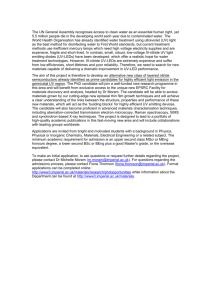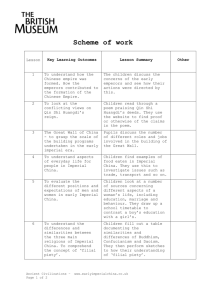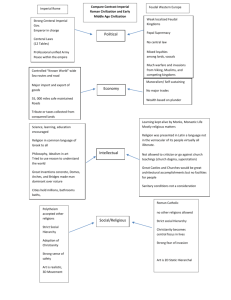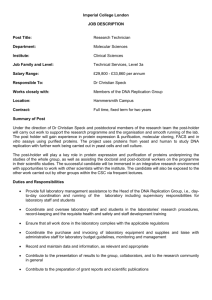European Red List of Birds 2015
advertisement
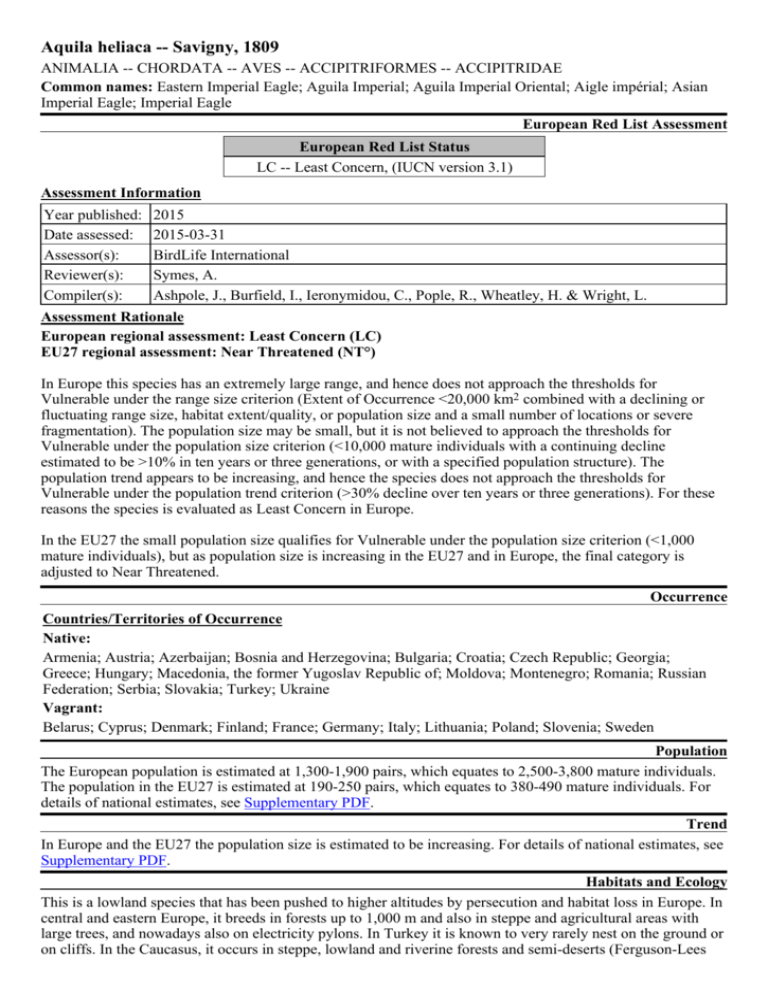
Aquila heliaca -- Savigny, 1809 ANIMALIA -- CHORDATA -- AVES -- ACCIPITRIFORMES -- ACCIPITRIDAE Common names: Eastern Imperial Eagle; Aguila Imperial; Aguila Imperial Oriental; Aigle impérial; Asian Imperial Eagle; Imperial Eagle European Red List Assessment European Red List Status LC -- Least Concern, (IUCN version 3.1) Assessment Information Year published: Date assessed: Assessor(s): Reviewer(s): Compiler(s): 2015 2015-03-31 BirdLife International Symes, A. Ashpole, J., Burfield, I., Ieronymidou, C., Pople, R., Wheatley, H. & Wright, L. Assessment Rationale European regional assessment: Least Concern (LC) EU27 regional assessment: Near Threatened (NT°) In Europe this species has an extremely large range, and hence does not approach the thresholds for Vulnerable under the range size criterion (Extent of Occurrence <20,000 km2 combined with a declining or fluctuating range size, habitat extent/quality, or population size and a small number of locations or severe fragmentation). The population size may be small, but it is not believed to approach the thresholds for Vulnerable under the population size criterion (<10,000 mature individuals with a continuing decline estimated to be >10% in ten years or three generations, or with a specified population structure). The population trend appears to be increasing, and hence the species does not approach the thresholds for Vulnerable under the population trend criterion (>30% decline over ten years or three generations). For these reasons the species is evaluated as Least Concern in Europe. In the EU27 the small population size qualifies for Vulnerable under the population size criterion (<1,000 mature individuals), but as population size is increasing in the EU27 and in Europe, the final category is adjusted to Near Threatened. Occurrence Countries/Territories of Occurrence Native: Armenia; Austria; Azerbaijan; Bosnia and Herzegovina; Bulgaria; Croatia; Czech Republic; Georgia; Greece; Hungary; Macedonia, the former Yugoslav Republic of; Moldova; Montenegro; Romania; Russian Federation; Serbia; Slovakia; Turkey; Ukraine Vagrant: Belarus; Cyprus; Denmark; Finland; France; Germany; Italy; Lithuania; Poland; Slovenia; Sweden Population The European population is estimated at 1,300-1,900 pairs, which equates to 2,500-3,800 mature individuals. The population in the EU27 is estimated at 190-250 pairs, which equates to 380-490 mature individuals. For details of national estimates, see Supplementary PDF. Trend In Europe and the EU27 the population size is estimated to be increasing. For details of national estimates, see Supplementary PDF. Habitats and Ecology This is a lowland species that has been pushed to higher altitudes by persecution and habitat loss in Europe. In central and eastern Europe, it breeds in forests up to 1,000 m and also in steppe and agricultural areas with large trees, and nowadays also on electricity pylons. In Turkey it is known to very rarely nest on the ground or on cliffs. In the Caucasus, it occurs in steppe, lowland and riverine forests and semi-deserts (Ferguson-Lees and Christie 2001, Meyburg and Kirwan 2013). Wetlands are apparently preferred on the wintering grounds. From late-February to early-May adults return to breeding areas. Both sexes construct a large stick nest, typically 100?150 cm in diameter with the nest cup lined with green sticks and other materials such as grass, fur and wool. Clutches are usually two to three eggs (Meyburg and Kirwan 2013). It hunts small to mediumsized mammals as well as birds and carrion. In the Caucasus the main prey include hare, tortoises, lizards and carrion (Tucker and Heath 1994). Adults in central Europe, the Balkan Peninsula, Turkey and the Caucasus are usually residents, whilst most immatures move south. (Meyburg and Kirwan 2013). Habitats & Altitude Habitat (level 1 - level 2) Artificial/Terrestrial - Arable Land Artificial/Terrestrial - Arable Land Artificial/Terrestrial - Pastureland Artificial/Terrestrial - Pastureland Forest - Temperate Forest - Temperate Grassland - Temperate Shrubland - Mediterranean-type Shrubby Vegetation Shrubland - Mediterranean-type Shrubby Vegetation Wetlands (inland) - Bogs, Marshes, Swamps, Fens, Peatlands Altitude 0-2000 m Importance suitable suitable suitable suitable major major suitable suitable suitable major Occasional altitudinal limits Occurrence breeding non-breeding breeding non-breeding breeding non-breeding breeding breeding non-breeding non-breeding Threats Breeding sites are threatened primarily by intensive forestry in the mountains, and by the shortage of large indigenous trees in the lowlands. Other threats are loss and alteration of feeding habitats, shortages of small and medium-sized prey species (particularly ground-squirrels Spermophilus spp.), human disturbance of breeding sites, nest robbing and illegal trade, shooting, poisoning and electrocution by powerlines. Habitat alterations associated with agricultural expansion threaten historical and potential breeding sites in former range countries. Hunting, poisoning, prey depletion and other mortality factors are also likely to pose threats along migration routes and in wintering areas. Threats & Impacts Threat (level 1) Agriculture & aquaculture Threat (level 2) Wood & pulp plantations (scale unknown/ unrecorded) Impact and Stresses Timing Scope Severity Ongoing Minority (<50%) Slow, Significant Declines Stresses Ecosystem conversion; Ecosystem degradation Biological resource Hunting & trapping Timing Scope Severity use terrestrial animals Ongoing Minority (<50%) Slow, Significant (intentional use Declines species is the target) Stresses Species mortality; Reduced reproductive success Biological resource Hunting & trapping Timing Scope Severity use terrestrial animals Ongoing Minority (<50%) Slow, Significant (persecution/ Declines control) Stresses Species mortality; Reduced reproductive success Biological resource Logging & wood Timing Scope Severity use harvesting Ongoing Minority (<50%) Slow, Significant (unintentional Declines effects: (large scale) Stresses [harvest]) Ecosystem degradation Human intrusions & Work & other Timing Scope Severity disturbance activities Ongoing Minority (<50%) Slow, Significant Declines Stresses Species disturbance; Reduced reproductive success Impact Low Impact Impact Low Impact Impact Low Impact Impact Low Impact Impact Low Impact Threats & Impacts Threat (level 1) Transportation & service corridors Threat (level 2) Utility & service lines Impact and Stresses Timing Scope Severity Ongoing Minority (<50%) Slow, Significant Declines Stresses Ecosystem degradation; Species mortality Impact Low Impact Conservation Conservation Actions Underway CITES Appendix I. CMS Appendix I and II. EU Birds Directive Annex I. It is legally protected in Armenia, Azerbaijan, Bulgaria, Croatia, Georgia, Greece, Hungary, Romania, Slovakia, Turkey and Ukraine. The Eastern Imperial Eagle Working Group was established in 1990. A European action plan was published in 1996 and its implementation reviewed in 2010 (Barov and Derhé 2011). Regional Action Plans have been published for the Balkan Peninsula (Stoychev et al. 2004) and for the Southern Caucasus (Horváth et al. 2006). The Eastern Imperial Eagle Management Guidelines for Hungary were published in 2005 (Kovács et al. 2006) and for Slovakia in 2007 (Demeter and Maderič 2007). Conservation Actions Proposed Conduct surveys to identify breeding and wintering sites, and migration routes. Improve protection of species and sites. Implement beneficial forestry policies. Maintain large trees in open land and protect old woodland on slopes (B. Hallmann in litt. 1999). Prevent mortality from nest robbing, nest destruction, illegal trade, poisoning and electrocution on medium-voltage powerlines, as well as persecution in wintering grounds and migratory routes. Maintain feeding habitats by preserving traditional land use. Increase the availability of prey species by habitat management. Raise public awareness and involve stakeholders in conservation activities. Bibliography Barov, B and Derhé, M.A. 2011. Review of The Implementation Of Species Action Plans for Threatened Birds in the European Union 2004-2010. Final report. BirdLife International For the European Commission. Demerdzhiev, D., Horváth, M., Kovács, A., Stoychev, S. and Karyakin, I. 2011. Status and Population Trend of the Eastern Imperial Eagle (Aquila heliaca) in Europe in the Period 2000-2010. Acta Zoologica Bulgarica S3: 5-14. Demeter, G. and Maderič, B. 2007. Imperial Eagle Management Guidelines. Raptor Protection of Slovakia. Ferguson-Lees, J., Christie, D.A. 2001. Raptors of the world. Christopher Helm, London. Heredia, B. 1996. International action plan for the Imperial Eagle (Aquila heliaca). In: Heredia, B., Rose, L. and Painter, M. (ed.), Globally threatened birds in Europe: action plans, pp. 159-174. Council of Europe, and BirdLife International, Strasbourg. Horváth, M., Kovács, A. and Gallo-Orsi, U. 2006. Action Plan for Imperial Eagle (Aquila heliaca) in the Southern-Caucasus. BirdLife International, Wageningen. Kovács, A., Demeter, I., Horváth, M., Fülöp, Gy., Frank, T. and Szilvácsku, Zs. 2005. Imperial Eagle management guidelines. MME / BirdLife Hungary, Budapest. Meyburg, B.U. and Kirwan, G.M. 2013. Eastern Imperial Eagle (Aquila heliaca). In: del Hoyo, J., Elliott, A., Sargatal, J., Christie, D.A. and de Juana, E. (eds.) 2013. Handbook of the Birds of the World Alive. Lynx Edicions, Barcelona. (retrieved from http://www.hbw.com/node/53159 on 16 January 2015). Stoychev, S., Zeitz, R. and Grubac, B. 2004. Plan for the Conservation of the Imperial Eagle in the Balkan Peninsula. Bulgarian Society for the Protection of Birds, Haskovo. Tucker, G.M. and Heath, M.F. 1994. Birds in Europe: their conservation status. BirdLife Conservation Series no. 3, BirdLife International, Cambridge. Map (see overleaf)

